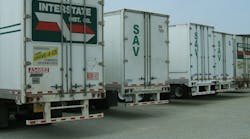The Insurance Institute for Highway Safety (IIHS) is renewing a call for stronger under-ride guard standards after tests it conducted on current models can be improved to better prevent passenger vehicles from sliding underneath the rear of trailers in a crash.
David Zuby, the Institute’s chief research officer, noted in a statement that “vehicle occupant protection” devices such as seat belts and airbags count for little when the front of a passenger vehicle ends up wedged under a tractor-trailer.
“When this happens, the top of the occupant compartment gets crushed because the structures designed to absorb the energy of a crash are bypassed, meaning the airbags and safety belts can’t do their jobs, and people inside can experience life-threatening head and neck injuries,” he noted.
IIHS petitioned the National Highway Traffic Safety Administration (NHTSA) in 2011 for tougher standards, also asking the agency to consider applying the standards to other types of large trucks, such as dump trucks that aren’t required to have any under-ride guards.
The group also noted that trailer makers are already installing guards that are much stronger than NHTSA requires due to standards established in Canada back in 2007 that require the device to withstand about twice as much force as required by the U.S. rule at the point where it attaches to its vertical support.
Still, IIHS said its recent series of crash tests with a 2010 Chevrolet Malibu striking a parked tractor-trailer at 35 mph shows that almost all current under-ride guard designs failed to prevent the vehicle from getting wedged under the trailer.
In tests involving eight models of dry van trailers, IIHS said when the car was aimed at the center of the trailer all successfully prevented under-ride, while tests in which only half the width of the car overlapped with the trailer all but one trailer passed.
However, when the overlap was reduced to 30%, every trailer except one built in Canada failed, IIHS said – stressing that a 30% overlap is the most challenging under-ride test because it is the minimum overlap under which a passenger vehicle occupant’s head is likely to strike a trailer if an under-ride guard fails.
The group said the reason it’s pushing hard for tougher under-ride guard standards is due to the significant difference in crash outcomes based on whether they work properly or fail. In tests where the guards held up, the Malibu’s structure and airbags protected the test dummy, with injury measures generally low and not life-threatening. By contrast, when the guards failed, head and neck injury measures were so high that real drivers would have died, IIHS said.
“Our tests suggest that meeting the stronger Canadian standard is a good first step, but … it’s possible to go much further,” Zuby noted.
Sean McNally, vp-communications for the American Trucking Associations (ATA) trade group, noted in a statement that trailer manufacturers are already taking steps to surpass current federal under-ride guard standards but that more focus should be placed on preventing rear-strike crashes in the first place.
“The best under-ride guard is the one that never needs to be used,” he explained. “More driver education on sharing the road with large commercial vehicles is a must, and promoting greater use of collision avoidance technology in both cars and trucks will also produce results. Many studies show that as many as three in four fatalities involving cars and trucks are unintentionally initiated or caused by the driver of the car. That’s why we believe education for all drivers is a critical component of improving highway safety.”
IIHS also referenced NHTSA fatality data as part of its call for stricter under-ride standards. In 2011, 260 of the 2,241 passenger vehicle occupants killed in large truck crashes died when the fronts of their vehicles struck the rears of trucks, according to NHTSA data – down from 460 out of 3,693 in 2004.
Yet the group noted that gaps in federal crash data make it difficult to pinpoint exactly how many of these crashes involve under-ride.
For example, a 2011 IIHS study of 115 crashes in which a passenger vehicle struck the back of a heavy truck or semitrailer found only about one-fifth involved no under-ride or negligible under-ride. However, nearly half of the vehicles had severe or catastrophic under-ride damage, and those vehicles accounted for 23 of the 28 fatal crashes in the study.
“While we’re counting on NHTSA to come up with a more effective regulation, we hope that in the meantime trailer buyers take note of our findings and insist on stronger guards,” Zuby added.



